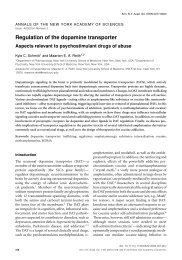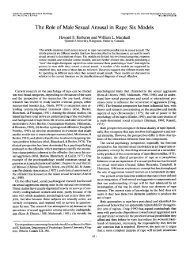Emotional modulation of the postauricular reflex
Emotional modulation of the postauricular reflex
Emotional modulation of the postauricular reflex
Create successful ePaper yourself
Turn your PDF publications into a flip-book with our unique Google optimized e-Paper software.
Emotion and <strong>the</strong> post-auricular <strong>reflex</strong> 427<br />
Moulder, Bradley, Requin, and Lang (1995) reported a parallel<br />
linear valence <strong>modulation</strong> pattern (i.e., aversive4pleasant) for <strong>the</strong><br />
H<strong>of</strong>fman <strong>reflex</strong>, a spinal flexion <strong>reflex</strong> elicited by aversive electric<br />
shock. In this study, <strong>modulation</strong> effects were stronger for<br />
emotional pictures <strong>of</strong> high intensity, and more pronounced for<br />
participants who rated <strong>the</strong> shock as aversive. In contrast to this,<br />
<strong>the</strong> magnitude <strong>of</strong> <strong>the</strong> spinal T <strong>reflex</strong>, elicited by nonaversive<br />
tapping or vibratory stimulation <strong>of</strong> <strong>the</strong> Achilles tendon, is<br />
comparably enhanced during both pleasant and unpleasant<br />
pictures in relation to neutral (Bonnet, Bradley, Lang, & Requin,<br />
1995)Fimplying facilitation by arousal (i.e., nonspecific activation;<br />
cf. Lang et al., 1990). An opposing quadratic pattern,<br />
involving inhibited probe response during both pleasant and<br />
aversive pictures compared with neutral, has been reported for<br />
o<strong>the</strong>r measures (e.g., noise-evoked P300 brain potential; Schupp,<br />
Cuthbert, Bradley, Birbaumer, & Lang, 1997). This pattern<br />
indicates a cross-modal attentional effect (cf. Anthony & Graham,<br />
1985) arising from <strong>the</strong> fact that visual affective stimuli draw more<br />
attention away from <strong>the</strong> acoustic modality (Lang et al., 1990).<br />
The Post-Auricular Reflex<br />
The post-auricular <strong>reflex</strong> is a vestigial muscle response in humans<br />
that acts to pull <strong>the</strong> ear backward (Gray, 1901/1995). It is<br />
recorded by positioning electrodes over <strong>the</strong> post-auricular muscle<br />
behind <strong>the</strong> ear (O’Beirne & Patuzzi, 1999). Because this <strong>reflex</strong> is<br />
evoked by an acoustic probe stimulus, it can be assessed<br />
concurrently with <strong>the</strong> startle blink (cf. Hackley, 1993). The<br />
post-auricular <strong>reflex</strong> has a much faster latency than <strong>the</strong> blink<br />
<strong>reflex</strong> (i.e., 9–11 ms vs. 45–50 ms; Hackley et al., 1987), implying<br />
a simpler brain stem circuitry. Following Cassella and Davis<br />
(1986), Hackley (1993) <strong>the</strong>orized that <strong>the</strong> circuit for <strong>the</strong> <strong>postauricular</strong><br />
<strong>reflex</strong> parallels <strong>the</strong> startle circuit in terms <strong>of</strong> input (i.e.,<br />
cochlear nucleus) and output (facial motor nucleus) components,<br />
but that it does not include <strong>the</strong> nucleus reticularis pontis<br />
caudalisF<strong>the</strong> juncture <strong>of</strong> <strong>the</strong> startle circuit at which input is<br />
received from <strong>the</strong> amygdala, accounting for <strong>the</strong> fear-potentiated<br />
startle effect (Davis et al., 1982). If this model <strong>of</strong> <strong>the</strong> <strong>postauricular</strong><br />
circuit is correct, one might expect a different pattern <strong>of</strong><br />
<strong>modulation</strong> for <strong>the</strong> post-auricular <strong>reflex</strong> compared with <strong>the</strong><br />
startle <strong>reflex</strong>.<br />
The post-auricular <strong>reflex</strong> has been assessed in a small number<br />
<strong>of</strong> attention studies in humans. The magnitude <strong>of</strong> this <strong>reflex</strong>, like<br />
that <strong>of</strong> startle, is attenuated if <strong>the</strong> <strong>reflex</strong>-eliciting noise is preceded<br />
by <strong>the</strong> occurrence <strong>of</strong> a transient acoustic stimulus (prepulse)Fan<br />
effect known as ‘‘prepulse inhibition’’ (Hackley, 1993; Hackley et<br />
al., 1987). Prepulse inhibition is thought to reflect a low-level<br />
sensory gating mechanism that affords ‘‘protection’’ at early<br />
stages <strong>of</strong> perceptual processing (Braff, Geyer, & Swerdlow, 2001;<br />
Graham, 1975). On <strong>the</strong> o<strong>the</strong>r hand, <strong>the</strong> post-auricular <strong>reflex</strong><br />
appears less subject to controlled attentional influences than<br />
startle. Hackley et al. (1987) reported that prepulse inhibition<br />
was enhanced for <strong>the</strong> startle <strong>reflex</strong>, but not <strong>the</strong> post-auricular<br />
<strong>reflex</strong>, when participants were instructed to attend to <strong>the</strong> prepulse<br />
stimulus. This dissociation in effects was interpreted in terms <strong>of</strong><br />
<strong>the</strong> faster, simpler circuitry <strong>of</strong> <strong>the</strong> post-auricular <strong>reflex</strong> (see also<br />
Hackley, 1993).<br />
However, when instructed to attend to one ear or <strong>the</strong> o<strong>the</strong>r in<br />
an auditory task, participants showed generally enhanced <strong>postauricular</strong><br />
<strong>reflex</strong> magnitudes, and enhanced prepulse inhibition <strong>of</strong><br />
this <strong>reflex</strong>, on <strong>the</strong> side to which attention was directed (Hackley,<br />
1993; Hackley et al., 1987). Hackley et al. (1987) attributed this<br />
effect to motor priming (i.e., a tensing <strong>of</strong> muscles on <strong>the</strong><br />
instructed side) ra<strong>the</strong>r than attention per se. Consistent with this,<br />
Patuzzi and O’Beirne (1999) reported a unilateral increase in<br />
baseline activity <strong>of</strong> <strong>the</strong> post-auricular muscle, and an affiliated<br />
increase in <strong>the</strong> magnitude <strong>of</strong> <strong>the</strong> post-auricular <strong>reflex</strong> to noise<br />
probes, when participants were instructed to rotate <strong>the</strong>ir eyes<br />
toward one side <strong>of</strong> <strong>the</strong> head or <strong>the</strong> o<strong>the</strong>r. On <strong>the</strong> o<strong>the</strong>r hand,<br />
it has been shown that activity in <strong>the</strong> post-auricular muscle region<br />
decreases during processing <strong>of</strong> near-threshold auditory<br />
stimulation compared with more intense auditory stimulationFconsistent<br />
with <strong>the</strong> idea that somatic activation decreases<br />
to enhance perceptual sensitivity during orienting (Stekelenburg<br />
& van Boxtel, 2001, 2002). However, <strong>the</strong> post-auricular <strong>reflex</strong><br />
was not assessed in <strong>the</strong>se latter studies, so it is unclear what<br />
impact <strong>the</strong>se changes in baseline EMG activity would have on its<br />
magnitude.<br />
Current Study<br />
The current study was conducted to examine modulatory effects<br />
<strong>of</strong> emotion on <strong>the</strong> post-auricular <strong>reflex</strong>. To do this, we delivered<br />
unwarned noise probes to participants during viewing <strong>of</strong><br />
pleasant, neutral, and unpleasant pictures and recorded<br />
responses <strong>of</strong> <strong>the</strong> post-auricular muscle behind each ear. To gain<br />
additional information about modulatory effects, we manipulated<br />
both <strong>the</strong> intensity and <strong>the</strong>matic content <strong>of</strong> pleasant and<br />
unpleasant pictures.<br />
The status <strong>of</strong> <strong>the</strong> post-auricular <strong>reflex</strong> as a defensive or<br />
appetitive <strong>reflex</strong> is unclear. However, <strong>the</strong> response-matching<br />
hypo<strong>the</strong>sis (Lang et al., 1990) makes clear predictions in ei<strong>the</strong>r<br />
case. If <strong>the</strong> post-auricular <strong>reflex</strong> is defensive in nature, it should<br />
be potentiated during aversive pictures and inhibited during<br />
pleasant pictures. If it is appetitive, it should be inhibited during<br />
unpleasant pictures and potentiated during pleasant pictures.<br />
Based on findings with <strong>the</strong> startle <strong>reflex</strong>, it was fur<strong>the</strong>r predicted<br />
that modulatory effects in ei<strong>the</strong>r case would be maximal for<br />
pleasant and aversive pictures <strong>of</strong> high intensity.<br />
The literature on affective <strong>modulation</strong> <strong>of</strong> startle and o<strong>the</strong>r<br />
<strong>reflex</strong>es provided a basis for alternative hypo<strong>the</strong>ses as well. One is<br />
that <strong>the</strong> post-auricular <strong>reflex</strong> might be facilitated by nonspecific<br />
arousal ra<strong>the</strong>r than valence, with magnitude greater during both<br />
pleasant and aversive pictures compared to neutral (cf. spinal T<br />
<strong>reflex</strong>; Bonnet et al., 1995). Ano<strong>the</strong>r is that <strong>the</strong> post-auricular<br />
<strong>reflex</strong> would be inhibited as a function <strong>of</strong> cross-modal attention,<br />
with <strong>reflex</strong> magnitude diminished during both pleasant and<br />
unpleasant pictures relative to neutral (cf. probe-elicited P300;<br />
Schupp et al., 1997).<br />
Method<br />
Participants<br />
Participants were 24 male undergraduates (M age 5 19.2 years,<br />
SD 5 1.25) recruited from psychology classes at <strong>the</strong> University <strong>of</strong><br />
Minnesota. The sample included only men because <strong>the</strong> current<br />
data were collected as part <strong>of</strong> a pilot for a project involving male<br />
prisoners. Individuals with visual or hearing impairments, as<br />
assessed via a screening questionnaire, were excluded from <strong>the</strong><br />
study. Students received course credit for <strong>the</strong>ir participation.<br />
Experimental Stimuli and Design<br />
Participants viewed digitized color photographs (22 pleasant, 22<br />
neutral, and 22 unpleasant) selected from <strong>the</strong> International<br />
Affective Picture System (IAPS; Center for <strong>the</strong> Study <strong>of</strong> Emotion










